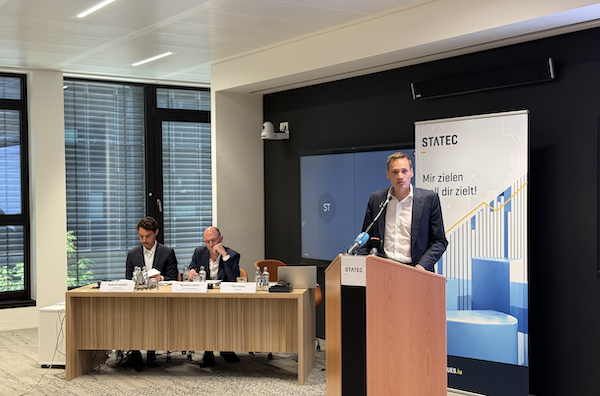 (L-R) Gabriel Gomes, Head of the Modelling and Forecasting Unit at STATEC; Bastien Larue, Head of the Short-term Analysis, Modelling and Forecasting Department; Tom Haas, Director of STATEC;
Credit: Ievgenii Karanov, Chronicle.lu
(L-R) Gabriel Gomes, Head of the Modelling and Forecasting Unit at STATEC; Bastien Larue, Head of the Short-term Analysis, Modelling and Forecasting Department; Tom Haas, Director of STATEC;
Credit: Ievgenii Karanov, Chronicle.lu
On Wednesday 25 June 2025, Luxembourg’s national statistics office, STATEC, presented its latest economic report, the Note de Conjoncture 1-25, titled "Between Military Conflicts and Trade War", at its headquarters in Belvaux.
STATEC reported a backdrop of international uncertainty and hesitant economic activity in Luxembourg at the start of 2025, pointing to modest growth this year and a slight improvement expected in 2026.
"In 2025, we have, first of all, huge uncertainties, and they have a direct impact on the economy worldwide, but on the economy in Luxembourg as well," said Tom Haas, Director of STATEC, in an interview with Chronicle.lu. "We have limited growth, only 1% this year, exactly as last year, both for the economy and for the employment market.”
He explained, Luxembourg’s small but highly open economy is especially sensitive to global developments. With exports and imports closely tied to international markets, external instability, including “several wars all over the world” and uncertainty around trade policy, continues to weigh heavily on economic activity in the Grand Duchy.
STATEC highlighted that global inflationary pressures have eased, leading to less restrictive monetary policies, especially in the euro area. However, recent international developments, notably the US pivot toward higher tariffs, have added uncertainty. Forecasts for global economic activity in 2025 and 2026 have been revised downward by most institutions. In the euro area, growth is expected to remain modest, below 1% in 2025, similar to 2024, with only a slight recovery in 2026. Market volatility tied to concerns over US economic policy could further limit growth prospects. Downside risks remain high, particularly due to recent geopolitical tensions in the Middle East.
Against this international backdrop, Luxembourg’s economy has shown signs of fragility at the start of the year. According to STATEC, following a strong Q4 2024 rebound, GDP contracted again in Q1 2025, mainly due to renewed volatility in the financial sector. While industry and construction have shown some improvement, activity in both sectors remains well below pre-pandemic and pre-energy-crisis levels. The national statistics office also noted that although business confidence in non-financial services picked up in mid-2024, it appeared more hesitant in early 2025.
Given these factors and a weaker international backdrop, STATEC has revised Luxembourg’s GDP growth forecast down to 1.0% for 2025 and 2.0% for 2026. This outlook assumes gradual improvement in market-based activity, though it could be undermined by heightened financial market uncertainty.
Inflation in Luxembourg edged up slightly in early 2025, mainly due to partial energy price deregulation and a new indexation in May. Overall price pressures remain stable, with services and food inflation still low compared to other EU countries.
No major inflationary shocks are expected in the next two years. Weak domestic and eurozone activity, combined with trade tensions unlikely to affect prices, should keep inflation under control. STATEC forecasts rates just below 2% in both 2025 and 2026, with the next wage indexation due in Q3 2026.
Wage cost growth slowed across the euro area in late 2024. In Luxembourg, reduced indexation frequency and temporary cuts to employer contributions curbed wage pressures in 2024. With those cuts ending, wage costs are set to rise 3.3% in 2025 and 2.3% in 2026.
Employment growth in Luxembourg has slowed since 2022 and remained subdued into early 2025, particularly in the private sector. While the unemployment rate continues to edge up, the pace has slowed compared to late 2024. Leading indicators point to a slight improvement.
STATEC anticipates a gradual recovery in 2026, driven mainly by public sector hiring, with limited support from market-sector employment.
Public finances showed strong performance in 2024, with revenues up 10%, boosted by corporate taxes and a VAT increase. Spending growth eased, particularly in energy-related subsidies, leading to a surplus of 1% of GDP.
Gabriel Gomes, Head of the Modelling and Forecasting Unit at STATEC, commented in an interview with Chronicle.lu: “Last year, corporate tax payments were more positive than we expected... We had a positive public balance in 2024. We expect 2025 to be rather neutral and then deteriorate and become negative in 2026.” He explained that some of this surprise stemmed from the structure of advance payments: “Companies pay taxes in advance, but when their performance is better, they owe money to the state. They have up to five years to pay it back, so it’s hard for us to know exactly when it’s going to come.”
Inflation is also expected to remain under control. “Inflation should not be a problem anymore, even if energy could have a higher contribution,” said Gabriel Gomes. “We still expect inflation to converge to 2% by 2026.”
STATEC projects a balanced budget in 2025, followed by a 0.9% deficit in 2026. Slower revenue growth, linked to planned tax cuts and weaker corporate receipts, will coincide with higher spending on social transfers, public wages, and investment.
Fossil fuels still account for 80% of global energy use, with markets remaining volatile. In Luxembourg, fossil fuel consumption continues to decline, mainly due to lower fuel and heating oil sales. STATEC expects drops of 3.5% and 6.5% respectively in 2025, with similar trends in 2026.
Following these developments, greenhouse gas emissions are projected to fall by 4% in 2024, 4.5% in 2025 and 5% in 2026, in line with Luxembourg’s National Energy and Climate Plan (PNEC).








